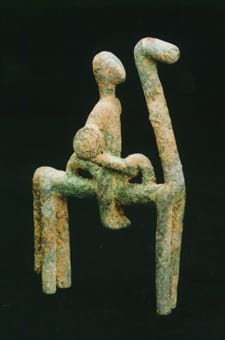Inland Niger River Delta Bronze Equestrian Sculpture, 12th Century CE - 14th Century CE
Bronze
3.25 x 4.5
PF.4934 (LSO)
This compact, powerful equestrian figure was made by one of Africa’s most inscrutable historical groups, the Inner Niger Delta. It depicts a very linear horse with an elongated neck, bearing...
This compact, powerful equestrian figure was made by one of Africa’s most inscrutable historical groups, the Inner Niger Delta. It depicts a very linear horse with an elongated neck, bearing a figure on its back which is – in turn – carrying a child across her (?) lap. Detailing is minimal, with the forms picked out as a series of interlocking straight and curvilinear forms. The patination is thick and even, implying a long interment.
The banks of the Niger River were home to numerous small groups during the supremacy of the Mali Empire (12th to 15th century AD), including the Bura, the Bankoni and the Inland Niger Delta (IND). All of these groups can be grouped in terms of their deconstructed figurative art, with more or less expressionistic rendering of features and limb proportions. Comparatively little is known of the culture itself, although it is likely to have been a trading group, within a large network of small satellite cultures. Their technology was impressive, and various metal pieces are known for the group. The presence of settled, stratified towns with well-defined elites is thus implied, especially as the traditional marker of elite status – the horse – is a popular stylistic element.
The role of this piece is uncertain as it lacks context. However, it is probably a representation of a mythological or historical ancestor, or perhaps an aspirational piece. This is a striking and impressive piece of ancient African art.
The banks of the Niger River were home to numerous small groups during the supremacy of the Mali Empire (12th to 15th century AD), including the Bura, the Bankoni and the Inland Niger Delta (IND). All of these groups can be grouped in terms of their deconstructed figurative art, with more or less expressionistic rendering of features and limb proportions. Comparatively little is known of the culture itself, although it is likely to have been a trading group, within a large network of small satellite cultures. Their technology was impressive, and various metal pieces are known for the group. The presence of settled, stratified towns with well-defined elites is thus implied, especially as the traditional marker of elite status – the horse – is a popular stylistic element.
The role of this piece is uncertain as it lacks context. However, it is probably a representation of a mythological or historical ancestor, or perhaps an aspirational piece. This is a striking and impressive piece of ancient African art.
